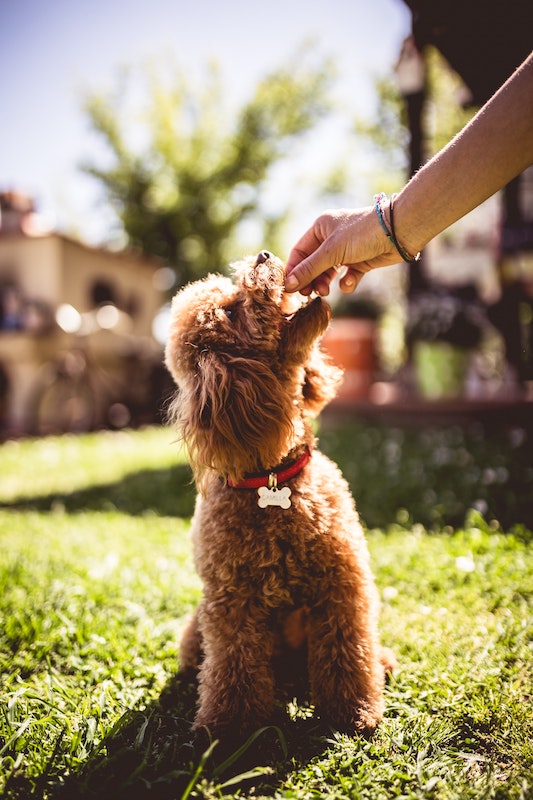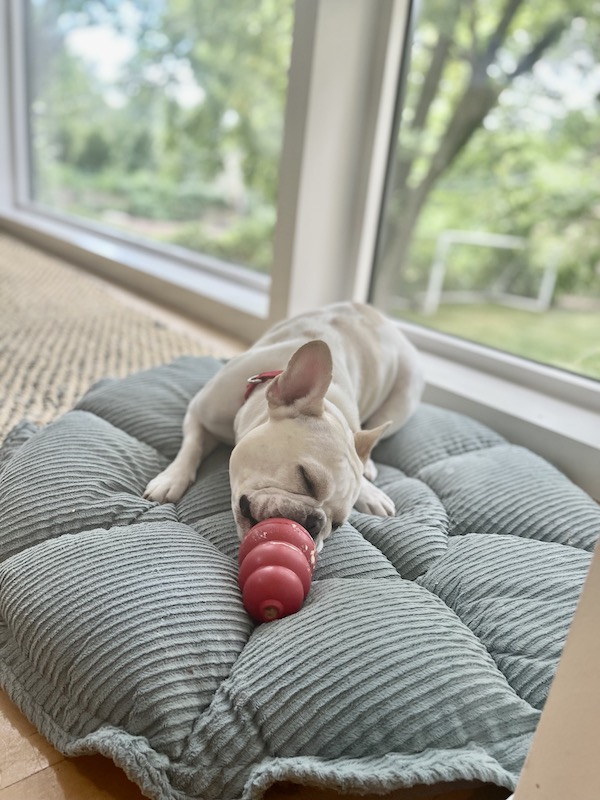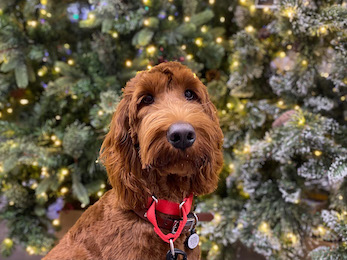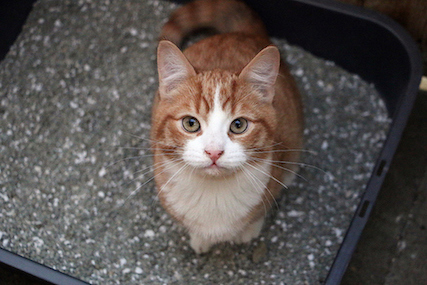Having trained puppies for nearly 20 years both in my home and in clients’ homes, I am often asked what my top training tips are for puppies. When thinking about how my clients can best use their time during such a critical puppy stage and get the most bang for their (effort) buck, I prioritize three puppy training tips:
- Tether your puppy or have your puppy drag a leash
- Use your puppy’s meals to your advantage
- Socialize your puppy properly
Tether your puppy or have your puppy drag a leash
My first training tip involves reducing effort for new puppy owners and preventing problem behavior from developing in puppies. The tip is an easy one– tether your puppy to something stationary or have your puppy drag a leash while you are home. When tethered, for safety, puppies should be secured to something that cannot be pulled over. Any items that could potentially be chewed should be removed and your puppy should be given 3-4 appropriate toys to chew. If your puppy chews the leash tether them with a leash that is chew-proof—a thin chain leash or a cable normally does the trick. Having puppies tethered, or if you are allowing them a bit more freedom, dragging a leash, gives you a big head start when it comes to training.
Benefits of tethering
First, tethering helps to reduce the development of problem behavior—specifically, house soiling, chewing, play biting, and jumping. So much of early puppy training involves managing your puppy’s environment. Not only are these behaviors more easily managed, but you can start teaching your puppy what to do before communicating what not to do. This gives you the time to teach appropriate behavior even before problem behavior is established.
Developing a food and water schedule and teaching your puppy to potty outside are important when starting a housebreaking program. Teaching your puppy to chew on toys or automatically sit for attention will directly compete with chewing, play biting, and jumping.

Tethering reduces the risk of problem behavior occurring
If your puppy is left to roam, unmonitored they will inevitably get into trouble. Potty accidents or chewing on something inappropriate are bound to happen. Unfortunately, if you do not catch your puppy in the act while having an accident or chewing, those undesirable behaviors will strengthen. Tethering reduces the opportunities to chew and if there is a potty accident, you will be more likely to see it. Your puppy may even start communicating the need to potty because they will be motivated to keep the area around them clean. Tethering your puppy reduces the opportunities for those behaviors to happen and gives you a much better chance of interrupting them if the behavior does occur.
Tethering your puppy to something stationary also controls their play biting and jumping behaviors. If allowed to roam free it would not be surprising if your puppy began to bite or jump on a family member. Once a bite or jump occurs with a loose puppy you have no choice but to intervene with physical contact or a verbal reprimand. Since play biting and jumping are both attempts at getting some form of attention, even poor-quality attention like physical contact or a verbal reprimand can serve as a small reward and worsen the problem behavior. Once again, tethering allows you to control your puppy’s access to attention and the environment. If your puppy is tethered and they jump or play bite, the person can simply walk away which will likely (mildly) punish those attention-getting behaviors and reduce them in the future.
Tethering your puppy also creates some physical separation from you. No puppy likes to be alone, but all puppies need to be alone at some point in their lives. The tether creates a physical restraint such that puppies cannot always access you. This helps to prepare your puppy for times when you are away. Using the tether teaches your puppy in a less traumatic way because you are still in sight. Most puppies do bark and cry when initially tethered. Just ignore the crying and when they are quiet, redirect them to a toy, ideally one that is stuffed with food!
As your puppy’s behavior improves and they begin learning appropriate behaviors to compete with some of these common household manners, you can begin giving them a bit more freedom and have them drag a leash throughout the house instead. Dragging the leash gives them more freedom, but still allows you to keep a close eye. If they do get into trouble, you can guide them with the leash rather than reaching directly for their collar which can be scary for some puppies and create other, more serious, problem behaviors later in life.
Use your puppy’s meals to your advantage


If you’re like me, part of getting a new puppy involves selecting all the fun gear that goes along with a new pet. The market is filled with cute leashes, collars, and food bowls and it can be fun to select the perfect items to match your pup. Unfortunately, if you take my advice and follow my second puppy tip, that decorative food bowl will need to be put away for the first several months of your puppy’s life! That’s because I recommend foregoing the bowl and instead making your puppy’s meals work to your advantage.
Your puppy has so much to learn and using your puppy’s meals puts you and them at an immediate advantage when it comes to learning a new skill or manner. Instead, I recommend feeding your puppy by hand, out of the crate, or out of toys.
Hand feeding
By feeding your puppy out of your hand, you can capitalize on teaching manners like an automatic sit for attention to prevent jumping. Hand feeding is also a great way to get kids involved in age-appropriate activities! Tether your puppy to something stationary and stand just out of reach. Guide them into a sit position. When they sit, feed one piece of kibble. Continue feeding quickly as long as they remain in the sit position. If they stand up, stop feeding and wait for them to sit again. Repeat for the duration of the meal.
The automatic sit is just the beginning when it comes to hand feeding your puppy! You should begin teaching the First 5 Commands to Teach a Puppy with their meals. Not only that but meals can be fed during socialization outings as well.
There is so much to do with a new puppy and teaching them with food establishes you as a source of positive reinforcement and capitalizes on all the great classical conditioning that food naturally brings. Feeding out of a bowl reduces your puppy’s interest in food and makes your job more challenging when it comes to training! Don’t worry, you’ll be able to pull out that cute new food bowl you bought in a matter of a few months, and you’ll have an obedient puppy to boot!
Feeding out of the crate
Sometimes hand feeding all meals can become overwhelming day in and day out. If that is the case for you and your new puppy is struggling with crate training or soils in their crate, you can alternate hand feeding meals with feeding off the floor of the crate. Remove any bedding and scatter the food on the floor of the crate. Feeding off the floor of the crate will help instill and maintain clean instincts in your puppy and motivate your puppy to keep their crate clean. Feeding off the floor of the crate also helps establish a positive association with the crate which reduces overall stress for your puppy when they are crated.
Feeding out of toys
Lastly, I recommend feeding puppies out of toys. This helps teach appropriate toy play which competes with inappropriate chewing and play biting. Feeding out of a toy also helps enrich your puppy and keep them busy when you are away or are busy yourself. I recommend moistening the food, mashing it, and then stuffing it into a food-stuffable toy. Depending on the skill level and age of your puppy, you can then give them the toy as is, partially freeze it, or fully freeze it. The more successful your puppy is with the toy, the more challenging you can make the toy.
Socialize your puppy properly
My third puppy tip involves socialization. A puppy’s socialization period is estimated to be from 3-12 weeks of age and is arguably the most critical time in their lives. It is important that puppies are not only exposed to new people, animals, and environments but that they have a pleasant experience when interacting with these individuals and new situations. Meals and treats can be paired with the presence of new people, animals, loud noises, and potentially scary environments—one way to get through all that hand feeding!
Socialization goals and tips
- Ideally, puppies should meet 20 new people, with a focus on children. Interactions with children should be monitored such that puppies are not being mishandled. Rather than smothering the puppy, children can be asked to help train them. Having kiddos hand feed puppies is a way to get them involved in a positive, appropriate manner.
- Puppies should also be exposed to 20 new vaccinated, friendly dogs per week. If you struggle to have your puppy meet 20 new dogs per week, regular walks at a local park should suffice. Monitored off-leash play with known, friendly dogs or other puppies is critical even if the volume does not amount to 20 other dogs or puppies.
- Puppies should be exposed to 3 novel locations per week. Locations should include parks, large box stores, and pet supply stores. If the puppy appears uncomfortable in any setting, that setting should be targeted more heavily. In addition to people, other dogs, and new, common environments, consider where and what the puppy will spend time doing as an adult (e.g., walking near a stroller, sitting at soccer games, going for a boat ride). Target those contexts during socialization outings as well.
By following my top three puppy training tips you will have a puppy whose behavior is easily managed, who is motivated to learn new and appropriate behavior, and who is properly socialized. Having a puppy can be a lot of work and the first few months can be overwhelming, but remember, you are making an investment in your and your puppy’s future. A lot of effort upfront will pay you dividends for over a decade with your beloved pet! Happy puppy training!




